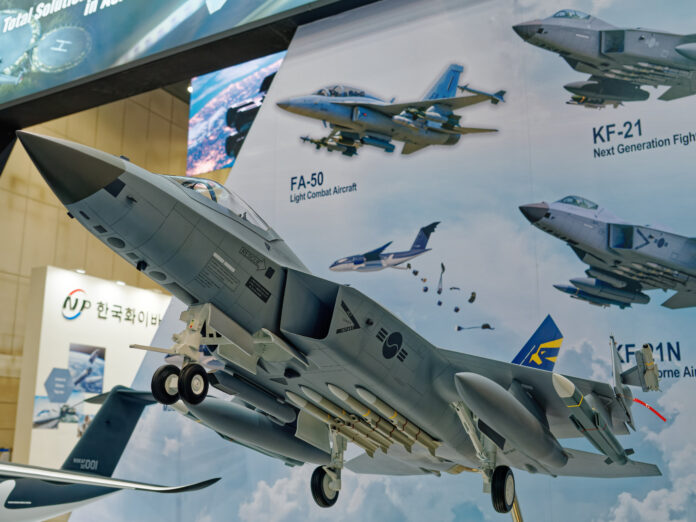Korea Aerospace Industries (KAI) has disclosed its interest to develop a carrierborne version of its 4.5-generation KF-21 multirole combat aircraft. A model of the KF-21N was shown for the first time in public at the DX Korea 2022 exhibition being held from 21 to 25 September.
However, a KAI official told AMR that development of the KF-21N will be entirely determined by the Republic of Korea Navy’s (RoKN’s) intent to acquire a purpose-built aircraft carrier, noting that the company would be able to commence production of the navalised aircraft “within a few years”.
According to company specifications, the KF-21N will be equipped with two General Electric F414 engines – the same type powering the baseline KF-21 – that will enable it to achieve an anticipated maximum speed of Mach 1.6. While the navalised design adopts a comparable physical profile, it is clearly distinguished by its larger size at 17.1 m and 5.2 m in length and height respectively (from 16.9 m and 4.7 m).
In particular, the KF-21N’s folding wings will be enlarged by around 20% to generate increased lift and enhance overall stability, an approach that would enable it to operate from either short take-off but arrested recovery (STOBAR) or catapult assisted take-off but arrested recovery (CATOBAR)-type aircraft carriers.
According to the official, other modifications to the baseline land-based aircraft design would include a strengthened fuselage and undercarriage to withstand the rigours of carrier aircraft launch and recovery operations, and the integration of an arrestor hook for landing manoeuvres.
The KF-21N model was also displayed with a full weapons loadout with two Diehl IRIS-T and four MDBA Meteor air-to-air missiles. A pair of hypersonic long-range air-to-surface cruise missiles – understood to be under planned development by the government-owned Agency for Defense Development (ADD) – were also integrated, although the company would not comment further on the future weapon.
South Korea revealed a plan in 2021 to develop a short take-off vertical landing (STOVL) aircraft carrier to the RoKN by 2033 under the CVX programme. By September that year, industry partnerships had already been formed – namely Hyundai Heavy Industries (HHI) and Babcock International, while DSME teamed up with Fincantieri and Hanjin Heavy Industries and Construction. However, the expectation then was that CVX will operate the STOVL Lockheed Martin F-35B Lightning II Joint Strike Fighter.
However, chairman of the Korean armed forces Joint Chiefs of Staff General Kim Seung-kyum told local media on 19 September that the country would consider an aircraft carrier that is larger and more capable than the originally proposed CVX design.
“The KF-21N is be aimed at addressing such a requirement should it receive funding,” said the KAI official.
The KF-21 is a multirole platform that will replace the Republic of Korea Air Force’s (RoKAF’s) ageing F-4D/E Phantom II and F-5E/F Tiger II aircraft. The RoKAF is expected to acquire over 300 aircraft by 2032.
KAI earlier stated that initial production aircraft will be optimised for air-to-air combat and will have limited air-to-ground capabilities. It will feature three hardpoints under each wing for weapons and/or external fuel stores, while missiles can also be externally carried under the fuselage. Serial production aircraft, however, will be fully capable of performing both mission sets. Low-rate initial production is expected to commence from 2026, with full-rate production following from 2028.
by Jr Ng













